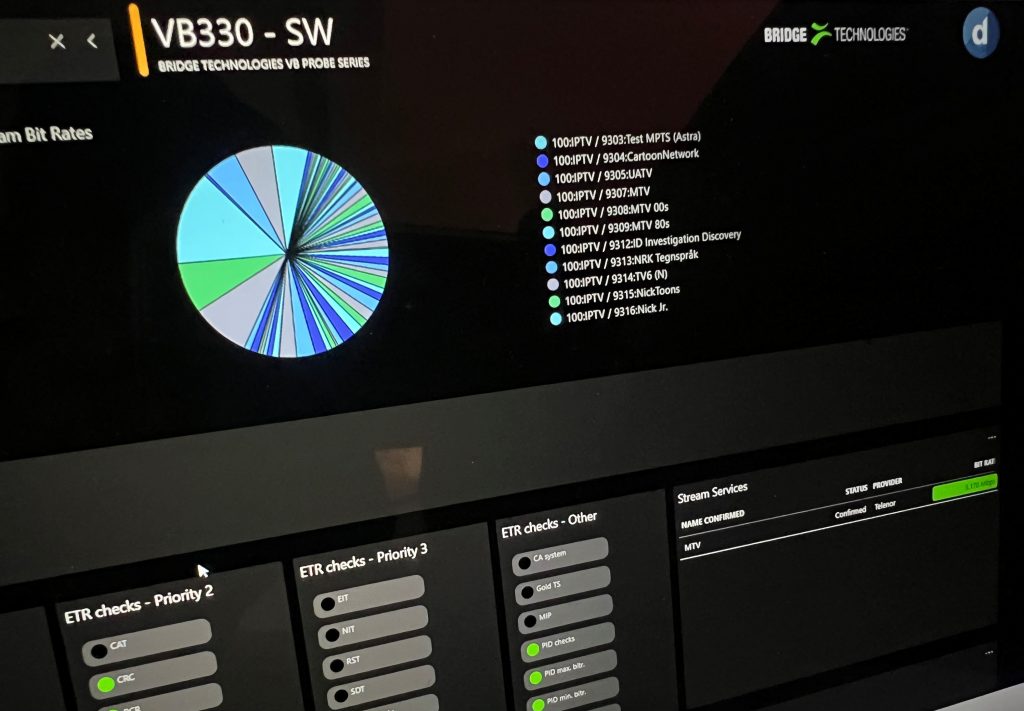Beyond the Engineer’s Office: APIs and the Expanding Language of Broadcast Insight
November 24, 2025
As seen in InBroadcast November
More than a handshake
When we talk about APIs in broadcast, we often focus on the engineering side: the flow of data between systems, the sharing of network measurements, and the elimination of silos. But APIs don’t just move information around – they define what that information means, and how it can be used. And knowledge of that fact needs to be at the forefront of developers’ minds when creating effective APIs.
That’s particularly true in the world of broadcast monitoring. Data from monitoring probes across the full broadcast chain has the ability to watch, analyse, and translate what’s happening at any and every given point: bitrates, packets, PIDs, alarms, and everything in between. And in many cases, the best place to view and understand that is within the ecosystem of the probe range itself – where UIs have been designed to meet the needs of engineers in the moment, putting what they need, where they need, at the right time.
But what if you aren’t an engineer? Or you’re an engineer working in a slightly different context to the broadcast norm? (In-so-far as one can even say there’s a norm…). Or your team of engineers have been bred and fed on a specific ecosystem or workflow? That’s where the idea of APIs for meaning becomes so important. Anybody building monitoring probes needs to also build doors into that data – gateways to understanding, in a way that can shape decision-making far beyond the racks.

From signal to strategy
At Bridge Technologies, we’ve been integrating that thinking into both the data our probes gather, and the APIs we develop to help push that data out into the field, where it can become the specific types of knowledge that users need.
Take our API for SCTE-35 data. On the surface, it’s an engineering function: a way to identify and list all SCTE-35-compliant streams, track every signal cue, and ensure ad-insertion triggers are firing when and where they should.
But through the API, that same data becomes a strategic asset.
When a broadcaster’s analytics platform pulls that SCTE-35 data, it can start to map exactly how advertising inventory performs in the real world – when breaks actually occur, how they align with audience peaks, and where revenue opportunities might be slipping through the cracks.
Suddenly, the API isn’t just helping to keep a transport stream compliant. It’s helping to write a boardroom report.
That’s the quiet power of a good API: it takes information that was once confined to the machine room and makes it meaningful to everyone from engineering to management.
One language, many dialects
Of course, SCTE-35 is just one example of that. We’ve split our APIs into distinct, usable areas of data – from the raw engineering layer to higher-level data that informs business decisions. For instance, the PID Export Data and OTT Export Data APIs give users a comprehensive view of the services and profiles being monitored, along with metadata that can be easily extracted, integrated, and repurposed. This means that whether you’re mapping multicast streams or tracking OTT delivery quality across adaptive profiles, the information is accessible and ready for use in other systems.
Similarly, the Alarm Event and Alarm Synchronisation APIs allow third-party platforms to ingest both real-time alerts and active fault states, enabling automated responses, consolidated dashboards, and historical analysis – all without having to manually query the probe itself.

Beyond these headline capabilities, the APIs also open up more nuanced operational intelligence. The MediaWindow™ Export Data API, for instance, provides second-by-second insight into every monitored stream, allowing operators to rebuild and analyse a full picture of bitrate, error and component-level performance over time. That level of granularity transforms the probe from a monitoring tool into a source of valuable trend data.
Together, these APIs turn the Bridge probe into what it was always meant to be – not an isolated monitoring endpoint, but a rich and open source of broadcast intelligence.
Why openness matters
It would be easy to treat APIs as just another checkbox feature – a way of ticking ‘interoperable’ on a spec sheet. But for Bridge Technologies, openness isn’t a side effect; it’s the point. Our probes don’t exist in isolation. They sit inside complex ecosystems where every component, vendor, and operator has their own preferred interface and toolset. Rather than forcing anyone into a single way of working, APIs let each organisation design workflows that match their own rhythm.
That requires a fair degree of work. API development isn’t just a case of saying ‘OK, I’ve done it’ – it’s far more a question of how it’s done. A good API needs to be developer-friendly, well-documented and browser-accessible, whether you’re integrating with a management system, building a custom analytics layer, or creating something entirely new. And for us at Bridge that’s been key, because we don’t just want to make our own data accessible – we want to make it useful.